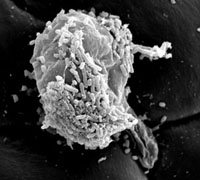Ecofisiología de Bacillus
 ECOFISIOLOGÍA DE Bacillus ANTAGONISTAS
ECOFISIOLOGÍA DE Bacillus ANTAGONISTAS
La creciente demanda de un suministro constante de alimentos saludables requiere de un eficiente control de las principales plagas y enfermedades. Las prácticas de control actuales están principalmente basadas en el uso de pesticidas sintéticos. El control biológico, esto es, el uso de antagonistas naturales para combatir plagas y enfermedades, ha emergido como una alternativa prometedora a los pesticidas químicos. Los bacilos aerobios formadores de endosporas ofrecen una serie de ventajas para su aplicación en biotecnología agrícola. Por un lado, estas bacterias producen diferentes tipos de compuestos insecticidas y antimicrobianos. Por otro, son capaces de inducir crecimiento y respuestas de defensa en la planta huésped. Además, las especies de Bacillus son capaces de producir esporas capaces de resistir condiciones ambientales adversas y permitir una fácil formulación y almacenamiento de productos comerciales. En esta línea de trabajo que desarrollamos en colaboración con la multinacional holandesa Koppert Biological Systems, estudiamos cepas de B. amyloliquefaciens previamente caracterizadas en nuestro laboratorio, con el objetivo último de desarrollar formulaciones comerciales de productos microbianos con actividad biofungicida y biofertilizante. Para ello analizamos la ecofisiología de procesos como la producción de antibióticos o la formación de biopelículas in planta, con objeto de desarrollar formulaciones con eficacia mejorada.
Investigadores Responsables: Alejandro Pérez García ResearcherID: D-9373-2013
Diego F. Romero Hinojosa ResearcherID: D-3849-2013
Miembros
Alejandro Pérez García
Diego F. Romero Hinojosa
Antonio de Vicente Moreno
Francisco M. Cazorla López
Jesús Hierrezuelo León
Montserrat Grifé
David Vela Corcía
PUBLICACIONES
Zeriouh H, de Vicente A, Pérez-García A, Romero D (2013) Surfactin triggers biofilm formation of Bacillus subtilis in melon phylloplane and contributes to the biocontrol activity. ENVIRONMENTAL MICROBIOLOGY 16:2196-2211.
García-Gutiérrez L, Zeriouh H, Romero D, Cubero J, de Vicente A, Pérez-García A (2013) The antagonistic strain Bacillus subtilis UMAF6639 also confers protection to melon plants against cucurbit powdery mildew by activation of jasmonate and salicylic acid-dependent defence responses. MICROBIAL BIOTECHNOLOGY 6: 264-274.
García-Gutiérrez L, Romero D, Zeriouh H, Cazorla FM, Torés JA, Vicente A, Pérez-García A (2012) Isolation and selection of plant growth-promoting rhizobacteria as inducers of systemic resistance in melon. PLANT AND SOIL 358: 201-212.
Yánez-Mendizábal V, Zeriouh H, Viñas I, Torres R, Usall J, de Vicente A, Pérez-García A, Teixidó N (2012) Biological control of peach brown rot (Monilinia spp.) by Bacillus subtilis CPA–8 is based on production of fengycin-like lipopeptides. EUROPEAN JOURNAL OF PLANT PATHOLOGY 132:609-619.
Zeriouh H, Romero D, García-Gutiérrez L, Cazorla FM, de Vicente A, Pérez-García A (2011) The iturin-like lipopeptides are essential components in the biological control arsenal of Bacillus subtilis against bacterial diseases of cucurbits. MOLECULAR PLANT-MICROBE INTERACTIONS 24:1540-1552.
Pérez-García A, Romero D, de Vicente A (2011) Plant protection and growth stimulation by microorganisms: biotechnological applications of Bacilli in agriculture. CURRENT OPINION IN BIOTECHNOLOGY 22: 187-193.
Romero D, de Vicente A, Zeriouh H, Cazorla FM, Fernández-Ortuño D, Torés JA, Pérez-García A (2007) Evaluation of biological control agents for managing cucurbit powdery mildew on greenhouse-grown melon. PLANT PATHOLOGY 56: 976-986.
Romero D, de Vicente A, Olmos JL, Dávila JC, Pérez-García A (2007) Effect of lipopeptides of antagonistic strains of Bacillus subtilis on the morphology and ultrastructure of the cucurbit fungal pathogen Podosphaera fusca. JOURNAL OF APPLIED MICROBIOLOGY 103: 969-976.
Romero D, de Vicente A, Rakotoaly RH, Dufour SE, Veening JW, Arrebola E, Cazorla FM, Kuipers OP, Paquot M, Pérez-García A (2007) The iturin and fengycin families of lipopeptides are key factors in antagonism of Bacillus subtilis toward Podosphaera fusca. MOLECULAR PLANT-MICROBE INTERACTIONS 20: 430-440.
Romero D, Pérez-García A, Veening JW, de Vicente A, Kuipers OP (2006) Transformation of undomesticated strains of Bacillus subtilis by protoplast electroporation. JOURNAL OF MICROBIOLOGICAL METHODS 66: 556-559.
Romero D, Pérez-García A, Rivera ME, Cazorla FM, de Vicente A (2004) Isolation and evaluation of antagonistic bacteria towards the cucurbit powdery mildew fungus Podosphaera fusca. APPLIED MICROBIOLOGY AND BIOTECHNOLOGY 64: 263-269.







